Early Cretaceous
The Early Cretaceous was a mild "Ice House" world. There was snow and ice during the winter seasons, and Cool Temperate forests covered the polar regions. Important Early Cretaceous - Wealden of Europe, Cloverly Formation of Montana, and Africa and South America. The Early Cretaceous stretched from 146 Ma to 100 Ma. In the Berriasian stage flora begins to transition from one dominated by conifers and cycads to angiosperms. Initially flowering plants play minor roles. The continents continue to seperate into north and southern assemblages. Sauropods, stegosaurs and allosaurids that characterized the Late Jurassic are replaced by ornithiscians, anklylosaurs and tyrannosaurs in northern Laurasian continents. Iguanodonts are common and widespread. Brachiosaurs some of them giants are present but uncommon. In the sourthern Gondwanan continents the Jurassic tradition lingers on with titainosaur sauropods, abeilosaurs and alloraurids dominating. Stegosaurs seem to be the big losers along with the diplodocids.
updated 110412
West Laurasia made up of North America and includes sharing Europe with African fauna from Gondwana. Large carniverous allosaurids, medium to small dromaeosaurs, and medium herbivors are the armored polacanthids, ornithopods and sauropods. The small plant eaters look pretty much the same as the Jurassic.

In Euope the Early Cretaceous Wealden Group forms outcrops covering a large part of south and south-eastern England including the Isle of Wight. It has yielded many fossils, including dinosaurs like Iguanodon and Hypsilophodon. Apart from fossils, it shows many other signs of being deposited in a continental environment.
Iberia is an island with a fauna related to England with sauropods and theropods.
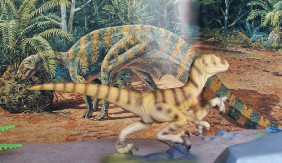
The North American dinosaurs are more similar to Early Cretaceous dinosaurs of Europe and Asia than they are to those from Africa or South America. Two important assemblages are Cedar Mountain and Cloverly Formations. Brachiosaurs and titanosaurs are important and ornithscians diversify as do theropods. The dominate diplodocids of the Jurassic have disapeared but the macromonians remain diverse but do not dominate.
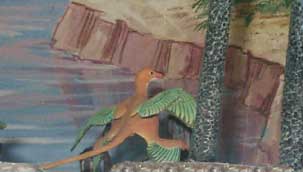 East Laurasia is Central Asia and Northern China. The large herbivores are now iguanodonts and therizinosaurs. Large theropods are poorly known. The ancestors of certopsians and hadrosaurs are developing. Sauropods are rare and stegosaurs fade out. A wide range of feathered dinosaurs have been recovered from Liaoning China. Fine volcanic ash perserved details not commonly found in fossils.
East Laurasia is Central Asia and Northern China. The large herbivores are now iguanodonts and therizinosaurs. Large theropods are poorly known. The ancestors of certopsians and hadrosaurs are developing. Sauropods are rare and stegosaurs fade out. A wide range of feathered dinosaurs have been recovered from Liaoning China. Fine volcanic ash perserved details not commonly found in fossils.
West Gondwana is North Africa and South America. The carnivores are spinosaurs, carcharodontosaurs and abeilosaurs. Diverse sauropods are large to medium plant eaters with iguanodonts are mostly small with a few medium speices. 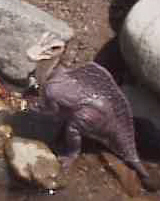 The Early Cretaceous in Africa is known primarily from the northern part of the continent, particularly Niger. The Early Cretaceous was an important time for the dinosaurs of Africa because it was when Africa finally separated from South America, forming the South Atlantic Ocean. Sauropods remained prominent in the southern hemisphere despite their drastic decline in the northern hemisphere. Large ornithopods were more scarce than their northern relatives; small ornithopods were common. Theropods in the South were often from families different from those in the North. Some dinosaurs had sails on their backs, Ouranosaurus, Rebbachisaurus.
The Early Cretaceous in Africa is known primarily from the northern part of the continent, particularly Niger. The Early Cretaceous was an important time for the dinosaurs of Africa because it was when Africa finally separated from South America, forming the South Atlantic Ocean. Sauropods remained prominent in the southern hemisphere despite their drastic decline in the northern hemisphere. Large ornithopods were more scarce than their northern relatives; small ornithopods were common. Theropods in the South were often from families different from those in the North. Some dinosaurs had sails on their backs, Ouranosaurus, Rebbachisaurus.
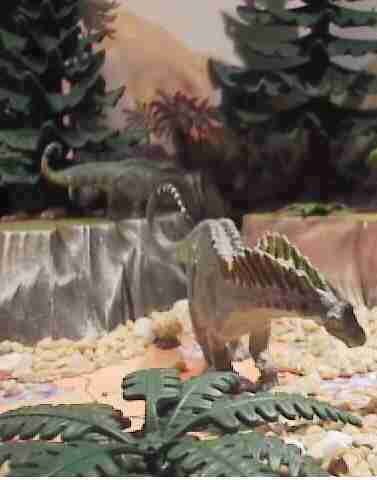 South American dinosaurs of the Early Cretaceous epoch, a stretch of time of which we know little about dinosaurs worldwide. Most of the newly discovered South American Early Cretaceous dinosaurs are various kinds of the sauropods Amargasaurus, Zapalasaurus and a titanosaurian sauropod. abelisauroid theropod Ligabueino and a stegosaur. The The La Amarga Formation is the only significant fossil site. Some seem closely related to certain Early Cretaceous dinosaurs from Africa, which is not surprising, because at that time South America and Africa were partly connected. Dinosaurs could have walked from one continent to the other.
South American dinosaurs of the Early Cretaceous epoch, a stretch of time of which we know little about dinosaurs worldwide. Most of the newly discovered South American Early Cretaceous dinosaurs are various kinds of the sauropods Amargasaurus, Zapalasaurus and a titanosaurian sauropod. abelisauroid theropod Ligabueino and a stegosaur. The The La Amarga Formation is the only significant fossil site. Some seem closely related to certain Early Cretaceous dinosaurs from Africa, which is not surprising, because at that time South America and Africa were partly connected. Dinosaurs could have walked from one continent to the other.
Polar Gondwana is Australia and Antartica. During the Aptian-Albian, Australia was located very near the South Pole with a temperate climate. There is evidence for unique sauropods and armored dinosaurs. Small ornithiscians seem to be most common. 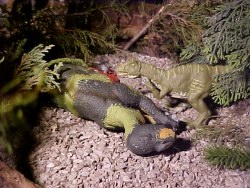 Australian Dinosaurs are best known from the Early Cretaceous epoch. Australia was within the Antarctic Circle, and dinosaurs show adaptations to life in seasonal darkness with small size and large eyes. Large Early Cretaceous Australian dinosaurs included the sauropod Austrosaurus, the plant-eater Muttaburrasaurus, and the large meat-eaterAustralovenator. Smaller dinosaurs included the hypsilophodontids Leaellynasaura, Atlascopcosaurus, and Fulgurotherium; the theropod Kakuru; and the armored Minmi.
Australian Dinosaurs are best known from the Early Cretaceous epoch. Australia was within the Antarctic Circle, and dinosaurs show adaptations to life in seasonal darkness with small size and large eyes. Large Early Cretaceous Australian dinosaurs included the sauropod Austrosaurus, the plant-eater Muttaburrasaurus, and the large meat-eaterAustralovenator. Smaller dinosaurs included the hypsilophodontids Leaellynasaura, Atlascopcosaurus, and Fulgurotherium; the theropod Kakuru; and the armored Minmi.
